There are three plausible scenarios to explain the strange carbon levels that NASA’s Curiosity Mars rover has collected at Gale Crater over the past nine years, one of which is the existence of extraterrestrial life.
According to Science Alert, a total of 24 powder samples have been heated by Curiosity – NASA’s famous rover-shaped exploration vehicle – to separate individual chemicals. These samples were crushed from sediments that Curiosity diligently collected by drilling numerous holes in the Gale Crater area from 2012 to 2021.

A sediment drilling hole of Curiosity – (Photo: NASA).
The analysis of the sediments shows a significant alteration in the ratio between carbon-12 and carbon-13 isotopes, which could reveal how the planet’s carbon cycle has changed over time.
Geologist Christopher House from Pennsylvania State University, a member of the research team, stated that both isotopes have existed since the formation of the Solar System and are found in everything related to it. However, carbon-12 reacts faster than carbon-13, so changes in the ratio of the samples could provide insights into the planet’s carbon cycle.
The changes in the carbon cycle can be explained by three scenarios:
- First, due to the influence of massive molecular clouds that the Solar System has passed through.
- Second, due to the process of converting CO2 into organic compounds like formaldehyde through abiotic processes.
- The third hypothesis is the most intriguing, which suggests a process similar to what occurred on ancient Earth: primitive bacteria converting methane into carbon. To confirm this extraterrestrial life hypothesis, scientists need to find more evidence of Earth-like conditions nearby.
So far, they have identified samples that are extremely depleted in carbon-13, remarkably similar to 2.7 billion-year-old sediment samples from Australia. These sediment samples bear evidence of ancient bacteria on Earth. Mars may have undergone something similar.
The research was recently published in the scientific journal PNAS.


















































